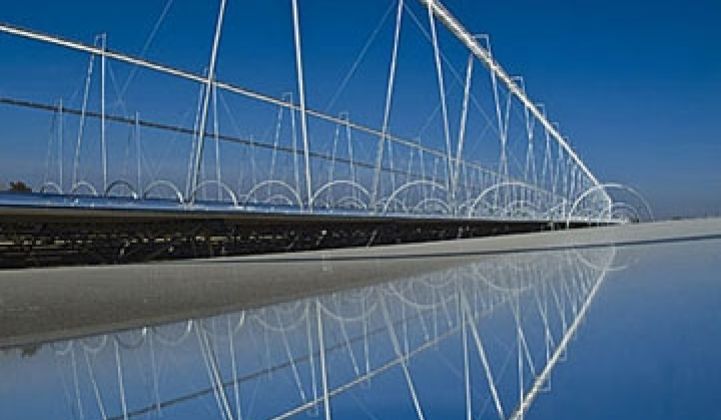Ausra plans to announce projects to build solar thermal plants in Australia, the Middle East and the United States by the end of the year, said CEO Bob Fishman Tuesday.
The Mountain View, Calif.-based company, which shifted its business model from being a power producer to a steam generation equipment supplier and builder, has deals to build plants in Queensland and New South Wales in Australia, Fishman said on the sideline at the AlwaysOn's GoingGreen conference in Sausalito, Calif.
Fishman declined to provide details of the new projects in Australia or elsewhere. One of projects in Australia could be a deal to sell its solar thermal equipment to a coalmine operator.
Ausra has already built a steam generation plant to help run the turbines at a 2-gigawatt coal-fired power plant in Liddell, Australia.
The company also has a contract for a 100-megawatt "solar-fossil fuel" project in the Middle East, he added
Ausra is even talking to a potential customer in Chile, though the discussion is still in the early stage, Fishman said.
The company initially set out to be a power producer by owning power plants and selling electricity from them to utilities. The plant would use flat mirrors to concentrate and direct the sunlight onto water-filled tubes to heat up the fluid to generate steam, which would then be piped to a turbine for electricity generation.
After signing some contracts and trying to raise money to carry out the projects, Ausra realized that, as a startup, it didn't have the muscles to line up financing, secure permits and build and own power plants.
In January this year, the company formally announced it would ditch that strategy and focus on using its equipment to build steam generation facilities (see Inside Ausra's Big Change).
This approach opens up a wide range of customers, from oil companies to food processors, as well as power producers, who could use the steam to run the turbines during the day when the sun shines and switch to natural gas when it's not.
It is easier for industrial customers to secure permits and lineup financing for building projects because the projects tend to be smaller than stand-alone power plants, Fishman said. A power plant typically runs in the hundreds of megawatts.
"You don't need a turbine. You just need to build a solar field," Fishman said.
Since announcing the change in business model, Ausra has said very little about its pending projects.
Meanwhile, its competitors are pursuing opportunities other than building and owning stand-alone power plants. Spain-based Abengoa Solar, for example, has built a 2.4-megawatt steam production plant with its solar thermal technology to make potato and corn chips at a Frito-Lay factory in Modesto, Calif.
Another solar thermal company, BrightSource Energy, is building a 29-megawatt solar steam plant in central California for Chevron, which would use the steam for loosening up petroleum underground to make it easier to recover (see BrightSource Snags Chevron Deal in Stealthy Move Into Solar Steam).
Oakland, Calif.-based BrightSource hasn't abandoned its plan to be a power plant developer. It plans to build 2.6 gigawatts of power projects in order to fulfill its power delivery contracts with the Pacific Gas and Electric Co. and Southern California Edison.
Fishman said previously that the company would still be interested in developing power plants down the road. The company began operating a 5-megawatt power plant last year to sell power to PG&E. It also has another power sales contract with PG&E that will require it to build a 177-megawatts power plant.
Image via Ausra.



